MaryAnn Bernal's Blog, page 308
March 7, 2014
Stonehenge holds a 'sonic secret,' says study
 The Stonehenge monument in England is seen, early Monday, June 21, 2010. (AP Photo/Lefteris Pitarakis)
The Stonehenge monument in England is seen, early Monday, June 21, 2010. (AP Photo/Lefteris Pitarakis) By Kate Seamons
There are no shortage of theories about Stonehenge, but few are so melodious as this: A recent study carried out by the Royal College of Art in London suggests that the monument holds a "sonic secret." The researchers' theory surrounds Stonehenge's bluestones, some of which hail from 200 miles away in Wales' Preseli Hills.
While archaeologists are still working to establish whether man or, perhaps, glacier carried them to Wiltshire, the Royal College of Art researchers suggest the rocks were intentionally brought to Stonehenge because of their "unique acoustic properties." As part of a larger study of the acoustic elements of the Pembrokeshire landscape where the bluestones hail from, it was discovered that many of the rocks in the area issue a metallic sound (akin to a bell or gong) where hit with a hammerstone.
In fact, the study notes that one Preseli village used bluestones as its church bells through the 1700s. The BBC reports that the researchers tested thousands of rocks, and that a high percentage rang "just like a bell," says a lead researcher.
"And there's lots of different tones, you could play a tune," he adds. In July, the team was granted permission to acoustically test Stonehenge's bluestones, and found that a number of them did indeed return a sound, though a slightly muted one, perhaps in part because some of the rocks have been shored up using concrete.
They also saw indications that some of the bluestones featured what could be strike marks; more study is needed on that front.
http://www.foxnews.com/science/2014/03/06/stonehenge-holds-sonic-secret-says-study/?intcmp=obinsite
Published on March 07, 2014 14:50
Remains of Europe's largest predatory dinosaur discovered in Portugal
 A Torvosaurus gurneyi dinosaur is seen in an undated artist's rendering. (REUTERS/SERGEY KRASOVSKIY)
A Torvosaurus gurneyi dinosaur is seen in an undated artist's rendering. (REUTERS/SERGEY KRASOVSKIY) Scientists in Portugal have discovered a new species of dinosaur -- possibly the largest land predator of any kind ever found in Europe.
Paleontologists Christophe Hendrickx and Octávio Mateus of Universidade Nova de Lisboa and Museu da Lourinhã in Portugal say the 33-foot-long dinosaur called Torvosaurus gurneyi was the scourge of Jurassic Europe, Reuters reported.
"It was indeed better not to cross the way of this large, carnivorous dinosaur," Hendrickx said. "Torvosaurus gurneyi was obviously a super predator feeding on large prey like herbivorous dinosaurs."
Remains of the species were unearthed by an amateur fossil hunter in 2003 in rock cliffs near Lisbon, Hendrickx told Reuters. He said fossilized embryos possibly belonging to the same species were identified last year in Portugal.
The predator, which roamed Europe 150 million years ago, weighed four to five tons, had a nearly 4-foot-long skull, possessed powerful jaws lined with blade-shaped teeth four inches long, and may have been covered with an early type of feather, Hendrickx said.
The scientists said this is the second species of the genus Torvosaurus. The Torvosaurus tanneri, which lived at the same time in North America, was identified in 1979.
The newly-identified predator is not only is the largest known meat-eating dinosaur from Europe, but is the biggest land predator of any kind ever found on the continent, according to Reuters.
"This is not the largest predatory dinosaur we know. Tyrannosaurus, Carcharodontosaurus, and Giganotosaurus from the Cretaceous were bigger animals," Hendrickx said in a news release referring to predators that appeared on Earth after the Jurassic period.
Carnivorous dinosaurs of the Jurassic period were typically medium-sized, with an average length of about 7 to 16 feet. Larger ones like Torvosaurus gurneyi lived in the late Jurassic period, according to Reuters.
"This animal, Torvosaurus, was already a fossil for 80 million years before the (Tyrannosaurus rex) ever walked the Earth," Mateus said.
http://www.foxnews.com/science/2014/03/06/remains-europe-largest-predatory-dinosaur-discovered-in-portugal/?intcmp=obinsite
Published on March 07, 2014 14:44
Team of European archaeologists find alabaster statue of Egyptian pharoanic princess in Luxor
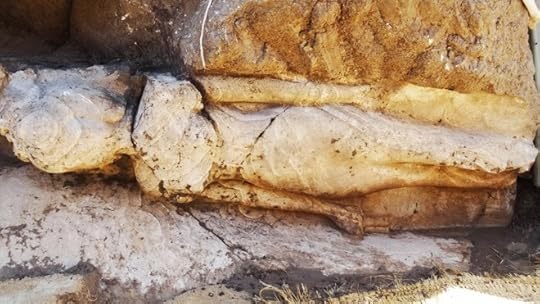 March 7, 2014: (AP Photo/Egypt's Antiquities Ministry)
March 7, 2014: (AP Photo/Egypt's Antiquities Ministry) CAIRO – Egypt has announced that a team of European archaeologists have found a nearly 6 ½-foot-tall alabaster statue of a pharoanic princess, dating from approximately 1350 B.C., outside the southern city of Luxor.
Minister of Antiquities Mohammed Ibrahim said in in a statement Friday that the statue was once part of a larger statue that was nearly 456 feet tall and guarded the entrance to a temple.
Ibrahim says the statue is of Iset, the daughter of Amenhotep III, and is the first found that depicts her without her siblings. Archaeologists uncovered the statue next to the funerary temple of Amenhotep III, who was worshipped as a deity after his death.
http://www.foxnews.com/science/2014/03/07/archaeologists-find-alabaster-statue-egyptian-princess/
Published on March 07, 2014 14:38
Lost first world war training battlefield discovered in Hampshire
 Soldiers march along the front line trench of a newly discovered first world war mock battlefield in Gosport, Hampshire. Photograph: Ben Mitchell/PA
Soldiers march along the front line trench of a newly discovered first world war mock battlefield in Gosport, Hampshire. Photograph: Ben Mitchell/PAMaev Kennedy
The Guardian, A few suspiciously straight lines in a corner of a 1951 aerial photograph showing acres of featureless scrubby heath have led archaeologists to a lost first world war landscape.
The mock battlefield, used for training soldiers before they were shipped across the Channel to confront the real thing, is complete with zig-zags of frontline, communication and reserve trenches, the enemy's front line, terrifyingly visible less than 200 yards away – and, a little further on, a holiday camp in Gosport, Hampshire.
Browndown is still owned by the Ministry of Defence, but well used by local dog walkers, who knew there were humps, bumps and hollows into which a dog could annoyingly vanish – but had no idea what they were.
Rob Harper, conservation officer at Gosport council, was originally studying the photograph looking for second world war pillboxes, and had to wait several weeks after he spotted the telltale marks – until the head-high bracken and gorse died back – before he could investigate the site.
He thought it was likely the earthworks had been destroyed since the photograph was taken, since Google Earth just showed a confusing jumble of tracks. But when he finally put on his boots and scrambled around the land, he found himself in a perfectly preserved complex covering acres of land.
The front trench was jagged so that even if the Germans broke through, they didn't get a clear line of fire along its entire length, and the communication trenches were wider so more men could be rushed up to the front – or carried back injured. Although very overgrown, the distinctive profile of the trenches is instantly familiar from countless wartime photographs.
"I was completely astonished at what I was seeing," Harper said. "It was quite personal to me too – I have seven relatives buried in war graves on the front, who could well have trained here."
The historian Dan Snow, who is also president of the Council for British Archaeology, which is working to record the site with English Heritage, said: "This is where archaeology and history dovetail perfectly. In a way this is where we have to side with Michael Gove and against the Blackadder view of history.
"This is where you can see on the ground that it wasn't just about rounding up young men and hurling them at the machine guns: they were being incredibly well trained."
Here military tacticians were also trying to invent a new form of warfare, desperate to break the terrible stalemate that the trenches represented. But according to Wayne Cocroft, an English Heritage expert on wartime archaeology, although 20 other trench training sites have been recorded across Britain, many have been damaged by later development, and both the scale and the state of preservation of the Gosport complex is exceptional.
So far no records have been found of the complex, but thousands of soldiers were trained, shipped out, and repatriated to Gosport throughout the war. The peninsula on the Solent is spattered with centuries of military relics, including barracks blocks, airstrips, naval bases, supply depots and a submarine base, which is now a museum.
Graham Burgess, deputy leader of the council – who graciously said that if the MoD would like to present them the land, after checking first for live ordnance, the council would be pleased to accept it – was not surprised, as an ex-navy man, that the site had kept its secrets for so long.
"Gosport was full of things happening behind high walls and barbed wire fences that nobody outside knew anything about – still has a few. You could live next door to one of these places and not have any idea what was going on inside."
Stephen Fisher, one of the archaeologists recording the site, says digging the trenches would also have been training for the men, who would soon have to do it for real, and the little slit trenches scattered across the site, just big enough for one man to cower in, might represent their first efforts.
Volunteers including armed forces members based in the area, including many for whom the site has a personal poignancy since they have just returned safely from active service overseas, will be helping record the site in detail.
The Council for British Archaeology and English Heritage are combining to encourage many more volunteers for the Home Front Legacy – a campaign to identify and record vulnerable sites including camps, drill halls and factories. The information will loaded onto a database to create a map of the social history of wartime Britain.
Cocroft said that records were better for a Tudor house than a 1914 site: one site recently identified, in Newcastle under Lyme, was a hall used as a sewing circle where women gathered to make bandages and knit and sew garments for soldiers on the front.
"There were so many charities for Belgian and Serbian refugees – where were they based, where did they meet? There were factories taken over to make things like wooden boxes for shells. These things aren't recorded on any maps – only local knowledge can help us find them, before the memory is lost forever. The Great War affected everybody in Britain – down to the children who were asked to gather conkers from which a chemical used in making cordite could be extracted – but there is so much of its social history which was never written down anywhere."
Culture secretary Maria Miller said she hoped local and family history groups, schools and parish centenary projects would get involved in the project: "Discovery, preserving and identifying for the public sites and buildings from that era will help bring that part of our national history alive for generations to come."
http://www.theguardian.com/world/2014/mar/07/lost-first-world-war-battlefield-discovered
Published on March 07, 2014 14:33
The Phil Naessens Show: The San Antonio Spurs Signature Win of the Season.
http://phillipnaessens.wordpress.com/2014/03/07/the-phil-naessens-show-the-san-antonio-spurs-signature-win-of-the-season/

On this edition of the Phil Naessens Show J.A. Sherman joins Phil to discuss the injury to OKC Thunder SG Thabo Sefalosha, the newly acquired Caron Butler, Phil takes his “Kiwi” test and much more Thunder talk. Mr. Brewtown joins Phil to discuss the potential starting lineup of the 2014 Milwaukee Brewers and J.R. Wilco joins Phil to disuss the San Antonio Spurs signature win over the Miami Heat and discuss Coach Greg Popovich’s coaching philosophy. --

On this edition of the Phil Naessens Show J.A. Sherman joins Phil to discuss the injury to OKC Thunder SG Thabo Sefalosha, the newly acquired Caron Butler, Phil takes his “Kiwi” test and much more Thunder talk. Mr. Brewtown joins Phil to discuss the potential starting lineup of the 2014 Milwaukee Brewers and J.R. Wilco joins Phil to disuss the San Antonio Spurs signature win over the Miami Heat and discuss Coach Greg Popovich’s coaching philosophy. --
Published on March 07, 2014 07:01
25 NEW Paperbacks to be given away FREE...
http://greenwizardpublishing.blogspot.co.uk/2014/03/25-new-paperbacks-to-be-given-away-free.html?view=classic
THE OFFER
Did I mention the word FREE?
Have I emphasised that enough?
This is The Night Porter.
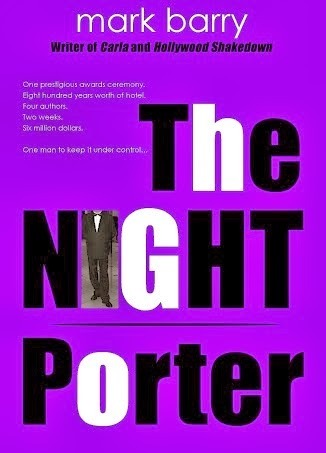
It is the first complete piece of work from Green Wizard/Mark Barry for a year.
It is approximately 250 pages long.
Those who have read the book so far - four people, my most trusted confidantes and allies - have described it as my best written work so far.
They don't bulls**t me either. They give it me good and proper if they think I need it, which is often.
Readers who have read my books, whether they like the stories I come up with or not, universally say I know my way around a keyboard. So that assessment means a lot.

The book is completely accessible.
It doesn't have the dark humour and shocking stories of Carla nor the cynical relationship monologues in Hollywood Shakedown.
It has none of the violence of the two football books - UV and BBVD - and none of the blood-curdling horror of The Ritual.
It is a puzzle, an experiment, an innovation. One of those lithographs of impossible design renaissance tricksters sold on Florence Market.
Every book I write, I try to do something different, something no-one else is doing.
Here's a big (unlike me) boast:
It's set in a hotel, in November, in the fictional town of Wheatley Fields, (based on Southwell, near Nottinghamshire, deep in Sherwood Forest). It is set over two weeks, underneath steel grey clouds of icy rain.
Four writers, all nominated for an upcoming awards ceremony, come to stay. One mega successful romance author, a top US thriller writer who sells in seven figures, a beautiful young YA tyro on the brink of world wide stardom...
...and a degenerate, nasty, bitter, jealous, trollish, drunken (but brilliant), self-published contemporary fiction author.
The eponymous, pseudonymous and anonymous Night Porter is instructed by a secretive and powerful awards committee to look after their EVERY need, to ensure they make it through the two weeks to attend the ceremony.
At the same time as keeping an eye on their wishes, antics, fights, relationships and never-ending ego explosions. And trying desperately to avoid getting involved himself.
It's a comedy drama about writers (and Night Porters!) with twists and turns, nooks and crannies, shadows and mirrors, alongside some of my bizarre preoccupations and obsessions.
It casts a sometimes shadowy light on modern publishing, the writing business - and the people in it.
Writers who like to read about writers and writing will enjoy the book.
They may not AGREE with the comments. In fact, I can think of two comments in there which are going to get us all in serious trouble, but it will make a writer think and react.

__________________________________________
THE DEAL
I (will) have 25 The Night Porters to give away in PAPERBACK. If you want an e-book instead, let me know. I prefer paperbacks so naturally I assume everyone else does (I'm just kidding, e-pop kids!).
Contact me on any media - FB, Twitter, Comments here - and when it is published, in approximately three weeks, I will POD the first 25 people to respond a copy and send it to your place.
I suggest that this will be in the UK and/or America as I will be doing this through Createspace.
Sorry - I had some trouble before with sending a book to Nepal and it left a lovely reader disappointed.

All I ask in return is that you review it on Amazon US/UK and any blog you have. If you can lend it to a pal after, then all the better. Not arsed about Goodreads.
Incidentally. If you HATE the book and my characters drive you mad, if you don't get past page thirty, if my comments and analyses leave you raging, or you don't think its very well organised, written etc, THEN GIVE ME A 1*.
Did you hear that bit?
A 1* is welcome if you think it is necessary. I won't troll you or comment. I'll just scratch my head like a man in a warm hat.
That is MUCH better than a no review. I am not swapping a book for a 5* review - I am swapping it for a review OF ANY KIND. I firmly believe it is quantity of reviews that is key rather than quality.
There you go, look, an opinion.
Believe me, it'll take you four or five hours to read. It is 250 pages long (ish) and has a magnificent sixties-retro matte Imperial Purple cover designed with Dawn of Dark Dawn Creations and it has been properly edited by Mary Ann Bernal.

It's the most readable and accessible book I have created. Hence the investment (I've been saving).
So. Contact me on FB, Twitter, my e-mail if you have it, or carrier pigeon.
I think you will enjoy the book. I'm hoping so and so are all the characters in the book.
Cheers, Mark/Wiz
Incidentally, if I am overwhelmed with applicants, which has happened before, I'll just put names in a hat. Ta!
THE OFFER
Did I mention the word FREE?
Have I emphasised that enough?
This is The Night Porter.

It is the first complete piece of work from Green Wizard/Mark Barry for a year.
It is approximately 250 pages long.
Those who have read the book so far - four people, my most trusted confidantes and allies - have described it as my best written work so far.
They don't bulls**t me either. They give it me good and proper if they think I need it, which is often.
Readers who have read my books, whether they like the stories I come up with or not, universally say I know my way around a keyboard. So that assessment means a lot.

The book is completely accessible.
It doesn't have the dark humour and shocking stories of Carla nor the cynical relationship monologues in Hollywood Shakedown.
It has none of the violence of the two football books - UV and BBVD - and none of the blood-curdling horror of The Ritual.
It is a puzzle, an experiment, an innovation. One of those lithographs of impossible design renaissance tricksters sold on Florence Market.
Every book I write, I try to do something different, something no-one else is doing.
Here's a big (unlike me) boast:
I don't think you will see an Indie published book like this anywhere in Cyberspace. Probably not a tradpubbed one either.
THE STORY
It's set in a hotel, in November, in the fictional town of Wheatley Fields, (based on Southwell, near Nottinghamshire, deep in Sherwood Forest). It is set over two weeks, underneath steel grey clouds of icy rain.
Four writers, all nominated for an upcoming awards ceremony, come to stay. One mega successful romance author, a top US thriller writer who sells in seven figures, a beautiful young YA tyro on the brink of world wide stardom...
...and a degenerate, nasty, bitter, jealous, trollish, drunken (but brilliant), self-published contemporary fiction author.
The eponymous, pseudonymous and anonymous Night Porter is instructed by a secretive and powerful awards committee to look after their EVERY need, to ensure they make it through the two weeks to attend the ceremony.
At the same time as keeping an eye on their wishes, antics, fights, relationships and never-ending ego explosions. And trying desperately to avoid getting involved himself.
It's a comedy drama about writers (and Night Porters!) with twists and turns, nooks and crannies, shadows and mirrors, alongside some of my bizarre preoccupations and obsessions.
It casts a sometimes shadowy light on modern publishing, the writing business - and the people in it.
Writers who like to read about writers and writing will enjoy the book.
They may not AGREE with the comments. In fact, I can think of two comments in there which are going to get us all in serious trouble, but it will make a writer think and react.

__________________________________________
THE DEAL
I (will) have 25 The Night Porters to give away in PAPERBACK. If you want an e-book instead, let me know. I prefer paperbacks so naturally I assume everyone else does (I'm just kidding, e-pop kids!).
Contact me on any media - FB, Twitter, Comments here - and when it is published, in approximately three weeks, I will POD the first 25 people to respond a copy and send it to your place.
I suggest that this will be in the UK and/or America as I will be doing this through Createspace.
Sorry - I had some trouble before with sending a book to Nepal and it left a lovely reader disappointed.

All I ask in return is that you review it on Amazon US/UK and any blog you have. If you can lend it to a pal after, then all the better. Not arsed about Goodreads.
Incidentally. If you HATE the book and my characters drive you mad, if you don't get past page thirty, if my comments and analyses leave you raging, or you don't think its very well organised, written etc, THEN GIVE ME A 1*.
Did you hear that bit?
A 1* is welcome if you think it is necessary. I won't troll you or comment. I'll just scratch my head like a man in a warm hat.
That is MUCH better than a no review. I am not swapping a book for a 5* review - I am swapping it for a review OF ANY KIND. I firmly believe it is quantity of reviews that is key rather than quality.
There you go, look, an opinion.
Believe me, it'll take you four or five hours to read. It is 250 pages long (ish) and has a magnificent sixties-retro matte Imperial Purple cover designed with Dawn of Dark Dawn Creations and it has been properly edited by Mary Ann Bernal.

It's the most readable and accessible book I have created. Hence the investment (I've been saving).
So. Contact me on FB, Twitter, my e-mail if you have it, or carrier pigeon.
I think you will enjoy the book. I'm hoping so and so are all the characters in the book.
Cheers, Mark/Wiz
Incidentally, if I am overwhelmed with applicants, which has happened before, I'll just put names in a hat. Ta!
Published on March 07, 2014 06:26
Elise VanCise novels - 50% off on Smashwords - limited time only
 Don't Touch and Half On sale this week only on Smashwords for 50% off! Use coupon code REW50 at checkout. https://www.smashwords.com/profile/view/elisevancise
Don't Touch and Half On sale this week only on Smashwords for 50% off! Use coupon code REW50 at checkout. https://www.smashwords.com/profile/view/elisevancise Elise VanCise, award winning author has been published in both print and digital media. Elise is a Florida Cracker, with a love for adventure and historic places. NaNoWriMo Municipal Liaison for Lake County, Florida, Founder of Lake Writers of Lake County, Florida.
Published on March 07, 2014 04:47
History Trivia - Henry VIII's divorce request denied
March 7

322 BC The Greek philosopher Aristotle died.

161, the emperor Antoninus Pius died peacefully of fever and was succeeded by his adopted sons Marcus Aurelius and Lucius Verus.

238 Roman subjects in Africa revolted against Maximinus Thrax and elected Gordian I as emperor.
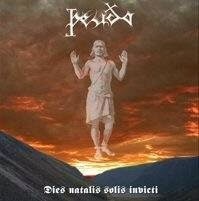
321 Emperor Constantine I decreed that the dies Solis Invicti (sun-day) was the day of rest in the Empire.
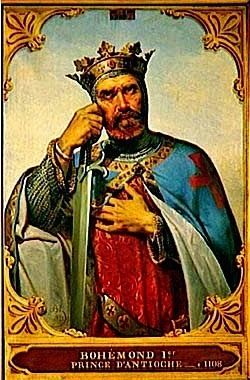 1111 Bohemond I of Tarente, leader of the First Crusade and a prince of Antioch, died.
1111 Bohemond I of Tarente, leader of the First Crusade and a prince of Antioch, died.

1274 Thomas Aquinas died.
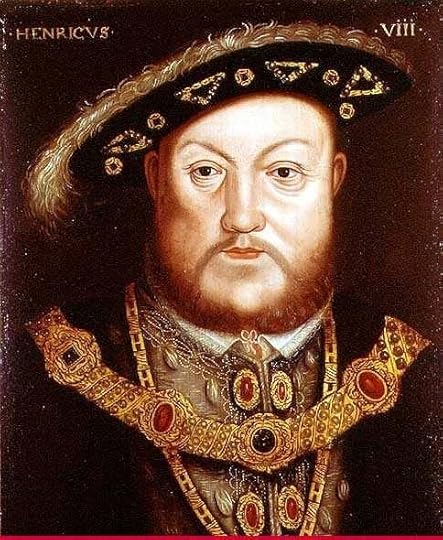
1530 King Henry VIII's divorce request was denied by the Pope, which prompted Henry to declare himself as supreme head of England's church.

322 BC The Greek philosopher Aristotle died.

161, the emperor Antoninus Pius died peacefully of fever and was succeeded by his adopted sons Marcus Aurelius and Lucius Verus.

238 Roman subjects in Africa revolted against Maximinus Thrax and elected Gordian I as emperor.

321 Emperor Constantine I decreed that the dies Solis Invicti (sun-day) was the day of rest in the Empire.
 1111 Bohemond I of Tarente, leader of the First Crusade and a prince of Antioch, died.
1111 Bohemond I of Tarente, leader of the First Crusade and a prince of Antioch, died. 
1274 Thomas Aquinas died.

1530 King Henry VIII's divorce request was denied by the Pope, which prompted Henry to declare himself as supreme head of England's church.
Published on March 07, 2014 04:38
March 6, 2014
Remembering Nicholas Brooks - Historian, archaeologist and authority on the Anglo-Saxons
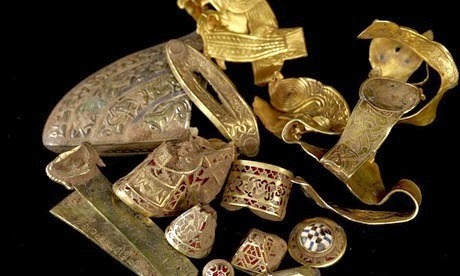 Items from the Staffordshire hoard unearthed in 2009, which were researched and interpreted by Nicholas Brooks, emeritus professor of medieval history at Birmingham University. Photograph: AP
Items from the Staffordshire hoard unearthed in 2009, which were researched and interpreted by Nicholas Brooks, emeritus professor of medieval history at Birmingham University. Photograph: APJinty Nelson
theguardian.com, The Anglo-Saxons retain a powerful grip on English imaginations. The discovery in 2009, just south of Watling Street, the ancient trackway paved by the Romans, of gold and silver artefacts that became known as the Staffordshire hoard attracted much attention but raised many questions. One of the few people equipped to propose solutions was Nicholas Brooks, emeritus professor of medieval history at Birmingham University, who was soon appointed to the panel co-ordinating research into the finds.
His was the kind of scholarship that reaches out to the public. Among his special interests were Anglo-Saxon kingdoms and warfare, and the payments, in the form of weapons and armour, owed by the elite as death duties to the king and recycled in the form of gifts to warriors. Nicholas convincingly explained the hoard's apparently odd composition – only the hilts and pommels of swords, for instance, not the blades – in terms of its being the working capital of one department of a royal armoury near Lichfield, the bishopric of the Anglo-Saxon kingdom of Mercia. The hoard was found south-west of Lichfield, and nearby is Tamworth, site of the chief Mercian royal residence.
Nicholas, who has died aged 73 of pancreatic cancer, was not only a historian. As a young archaeologist, he identified one of King Alfred's forts, and discovered the structure of another's ramparts. An early paper, co-authored with his former school history master Harold Walker and published in Anglo-Norman Studies Vol 1 in 1978, found unsuspected evidential value in the arms and armour depicted in the Bayeux Tapestry. But his greatest achievements lay in the study of documents.
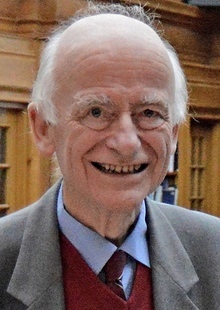 Anglo-Saxon Canterbury was central to Nicholas Brooks's work. Photograph: Chris Robinson Born in Virginia Water, Surrey, Nicholas was the son of WDW Brooks, a consultant physician at St Mary's hospital, Paddington, London, and Phyllis (nee Juler), a physician's daughter and talented pianist and figure-skater. The third of their four children, he was educated at Winchester college, and graduated in history from Magdalen College, Oxford, in 1961.
Anglo-Saxon Canterbury was central to Nicholas Brooks's work. Photograph: Chris Robinson Born in Virginia Water, Surrey, Nicholas was the son of WDW Brooks, a consultant physician at St Mary's hospital, Paddington, London, and Phyllis (nee Juler), a physician's daughter and talented pianist and figure-skater. The third of their four children, he was educated at Winchester college, and graduated in history from Magdalen College, Oxford, in 1961.His interests and imagination had been fired originally by stays at the family's holiday cottage in Kent, which lay on the continuation of Watling Street south of Canterbury. He became fascinated by Kent's historic landscape. As a mature scholar, he showed, in a brilliant foray into the 14th century, the effectiveness of the communication strategies used by Kentishmen in the Peasants' Revolt of 1381.
A series of path-breaking earlier medieval studies proved that works ordained by medieval kings to maintain the bridge over the river Medway at Rochester, and persisting in various administrative incarnations until the Bridge Trust of the present day, originated in late Roman arrangements. Nicholas's view was long, and never insular.
Anglo-Saxon Canterbury was central to Nicholas's life's work. His Oxford DPhil on the Canterbury charters, supervised by Professor Dorothy Whitelock at Cambridge, was finished in 1969 and published as The Early History of the Church of Canterbury (1984). The charters record donations of property to the church, nearly all by lay benefactors, giving details of where estates lay and how valuable they were, when they were received, on what terms leases were granted, and disputes arising later. What makes Canterbury's charters special is their large number, the fact that they mostly survive as originals, and that through them can be traced the workings of lay piety, and the buildup of Canterbury's lands through the Anglo-Saxon period, which explains its importance as a great institutional landowner with huge political clout.
The full edition of the 185 charters, completed through 30 years' further editorial labours, shared between Nicholas and his colleague Susan Kelly, with unstinting support from the British Academy, was published in the two bulky volumes of Charters of Christ Church Canterbury (2013). Canterbury's archival hoard brings to light earlier medieval English history in all its guises: religion, language (many are in Old English), law and politics, landscape and economy, and connections with continental Europe.
While still working on his DPhil, Nicholas was appointed in 1964 to his first academic post, at the University of St Andrews. There he met Chlöe Willis, whom he married in 1967, and there they stayed until 1985.
In 1978, when Nicholas became general editor of the series Studies in the Early History of Britain (later, Studies in Early Medieval Britain), he gave a memorable paper to the Royal Historical Society on King Alfred mobilising his people against Viking attacks. Thirty volumes of studies were published under his guidance, and four under his personal editorship or co-editorship: Latin and the Vernacular Languages in Early Medieval Britain (1982), St Oswald of Worcester (1996), St Wulfstan and his World (2005) and Early Medieval Studies in Memory of Patrick Wormald (2009). These publications were important in establishing an approach to Anglo-Saxon England that understood it in the context of the whole of the British Isles and contacts with continental Europe.
In 1985, Nicholas was appointed to the chair of medieval history at Birmingham University. There, history prospered under his wise and supportive headship, as did the faculty of arts during his stint as dean. He was elected a fellow of the British Academy in 1989. After his retirement in 2004, a group including several of his former students, now academics themselves, produced a festschrift, Myth, Rulership, Church and Charters (2008), testimony to Nicholas's personal warmth and kindness as well as to his academic distinction.
There are two stories of Nicholas's retirement, both true. One is that he spent more time with Chlöe and the family, that he continued to enjoy gardening and walking, that he and Chlöe found new enjoyment in choral singing, and that he spent more time on bridge playing than bridge archaeology. The other is that the Canterbury charters were published, as were several substantial papers, including two of his most original on the Anglo-Saxon Chronicle, that he continued to supervise research students, that he presided as he had since 1991 over the British Academy's Anglo-Saxon charters project, and that he continued to sit on the fabric advisory committees of two great cathedrals, Canterbury and Worcester. King Alfred left his memory in good works; Nicholas followed suit.
He is survived by Chlöe, a daughter, Ebba, and a son, Crispin, and three grandchildren.
• Nicholas Peter Brooks, medieval historian, born 14 January 1941; died 2 February 2014
http://www.theguardian.com/education/2014/mar/06/nicholas-brooks
Published on March 06, 2014 14:20
16th-century artillery manual shows illustration of 'rocket cat' weaponry
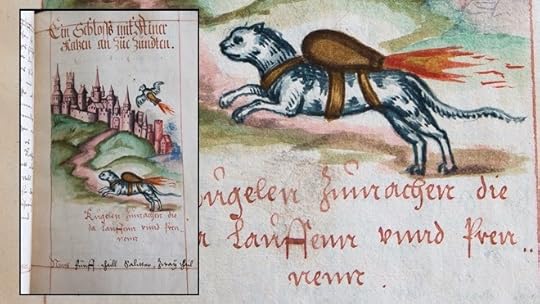 PHILADELPHIA – You're a 16th century German prince plotting to crush a peasant rebellion, or perhaps you're leading an army against the Ottoman Empire or looking to settle the score with a rival nobleman. What's a guy looking for a tactical edge to do?
PHILADELPHIA – You're a 16th century German prince plotting to crush a peasant rebellion, or perhaps you're leading an army against the Ottoman Empire or looking to settle the score with a rival nobleman. What's a guy looking for a tactical edge to do?Bring on the rocket cats!
Fanciful illustrations from a circa-1530 manual on artillery and siege warfare seem to show jet packs strapped to the backs of cats and doves, with the German-language text helpfully advising military commanders to use them to "set fire to a castle or city which you can't get at otherwise."
'It clearly looks like there's some sort of jet of fire coming out of a device strapped to these animals.'- Mitch Fraas, a historian and digital humanities expert at the University of Pennsylvania libraryDigitized by the University of Pennsylvania, the unusual, full-color illustrations recently caught the attention of an Australian book blog and then found their way to Penn researcher Mitch Fraas, who set out to unravel the mystery.
"I really didn't know what to make of it," said Fraas, a historian and digital humanities expert at the Penn library. "It clearly looks like there's some sort of jet of fire coming out of a device strapped to these animals."
So were these unfortunate animals from the 1500s really wearing 20th-century technology?
Fraas' conclusion: No. Obviously.
The treatise in question was written by artillery master Franz Helm of Cologne, who was believed to have fought in several skirmishes against the Turks in south-central Europe at a time when gunpowder was changing warfare.
Circulated widely and illustrated by multiple artists, Helm's manual is filled with all sorts of strange and terrible imagery, from bombs packed with shrapnel to missile-like explosive devices studded with spikes -- and those weaponized cats and birds.
According to Fraas' translation, Helm explained how animals could be used to deliver incendiary devices: "Create a small sack like a fire-arrow. If you would like to get at a town or castle, seek to obtain a cat from that place. And bind the sack to the back of the cat, ignite it, let it glow well and thereafter let the cat go, so it runs to the nearest castle or town, and out of fear it thinks to hide itself where it ends up in barn hay or straw it will be ignited."
In other words, capture a cat from enemy territory, attach a bomb to its back, light the fuse and then hope it runs back home and starts a raging fire.
Fraas said he could find no evidence that cats and birds were used in early modern warfare in the way prescribed by Helm.
A good thing, too.
"Sort of a harebrained scheme," Fraas said. "It seems like a really terrible idea, and very unlikely the animals would run back to where they came from. More likely they'd set your own camp on fire."
http://www.foxnews.com/science/2014/03/06/16th-century-artillery-manual-rocket-cat-weaponry/
Published on March 06, 2014 14:11



